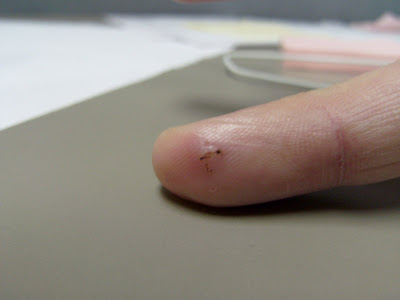Note: Once again, I will say
this is a highly experimental, possibly dangerous procedure with unknown side effects. While Parylene C is biocompatible and used in similar applications, a magnetic laboratory stir disc is far from a surgical grade implant. I would recommend against seeking out this type of implant until it is very clear that it is a viable long-term solution.
Finger 3 days after implantation (the stuff above the cut is the remnant of a New Skin liquid bandage which I used the first day.):

After receiving several sample stir discs I decided it was time to go back to ----- and show them to -----, who would ultimately be doing the procedure. I initially thought that he would want to examine the implants, then schedule a time to come in and do the procedure. We looked at and discussed the various magnets that I had brought, and showed him the one that I intended to have implanted: a 3.7 mm x .7 mm Parylene C coated stir disc. He offered to go forward with the procedure right then and there, and I enthusiastically agreed.
*I have put ----- in place of names until I get the go-ahead... have to respect privacy you know!
He sterilized the coated magnet using a solution (using an autoclave would have destroyed both the coating and the magnet) and laid out the various supplies that would be needed. He walked me through the procedure one more time, then we began.
To give him the best angle for working, I sat, then twisted my arm counterclockwise 3/4 of a turn from palm facing down (imagine making a 'C' with your index finger and thumb flat on the table.) While a bit uncomfortable for me, it also helped me keep perfectly still. The implant was to be located where I had previously decided, on my right ring finger, on the side of the tip.
After a deep breath he inserted a 6 gauge needle deeply enough to make an incision the width of the magnet. (about 3.5 mm). This was the painful part of the procedure and felt, well, like having a needle poked in to my finger. He removed the needle, then pushed the magnet in to the hole (which I barely felt at all) using his finger. He then pushed the implant a bit deeper using the back of a 10 gauge needle. The wound bled a little, but not excessively. He put pressure on it using gauze and the bleeding stopped almost immediately. We had discussed the possibility of using a single suture if necessary, but the bleeding was minimal so we decided not to stitch. (hindsight tells me that a stitch may have been a good idea anyway.) The procedure was done in about one minute.
We discussed aftercare, which turned out to be easy. Unlike a piercing or dermal anchor, we actually want the skin to heal the way it originally was. Given that the wound clotted and closed up almost immediately it would be no worse than healing a small finger injury. He asked me to come in after a day or two to check on healing progress and I headed home.
For about an hour and a half after the procedure it throbbed and ached slightly, but that soon subsided. It remained very tender and sensitive to the touch for the rest of the evening. Curiosity got the better of me and I passed my finger close to the strong magnet on my cell phone (the model I have has a rare earth magnet to hold a sliding mechanism open/closed.) I felt the implant move within my finger, and it was unlike
anything I had ever felt.
I spent most of the night with my hand in an elevated position, finger pointed up. I was concerned that if I were not careful the magnet would migrate closer to the entry point - or even worse - emerge from the hole.
After waking up the next day, I cleaned the wound and applied a fresh coating of New Skin. While still slightly sore to the touch, much of the discomfort was gone. I went about a normal day, and bumped/squeezed/grabbed with the healing finger several times accidentally, which resulted in a few moments of sore throbbyness. The area just below the entry point was the most sore, and gentle prodding revealed a slightly harder spot directly underneath it. I was very concerned that the implant had migrated. To verify, I placed a small magnet above my finger, and it stuck to the skin a good distance from the entry wound. Fortunately, the implant had not migrated at all. In the future, I would DEFINITELY recommend using a single suture to close the incision, even if it is not necessary to stop the bleeding. It would serve to provide a barrier to prevent the magnet from emerging if it did end up migrating. I switched from New Skin to a simple band-aid with Neosporin applied to it, changing as necessary.

A magnet attracted to the implant
I'm very anxious to feel the results after my finger has finished healing.
 The little yellow dot shows the approximate location of my implant, and the red circle shows where the sensations are strongest.
The little yellow dot shows the approximate location of my implant, and the red circle shows where the sensations are strongest.



















